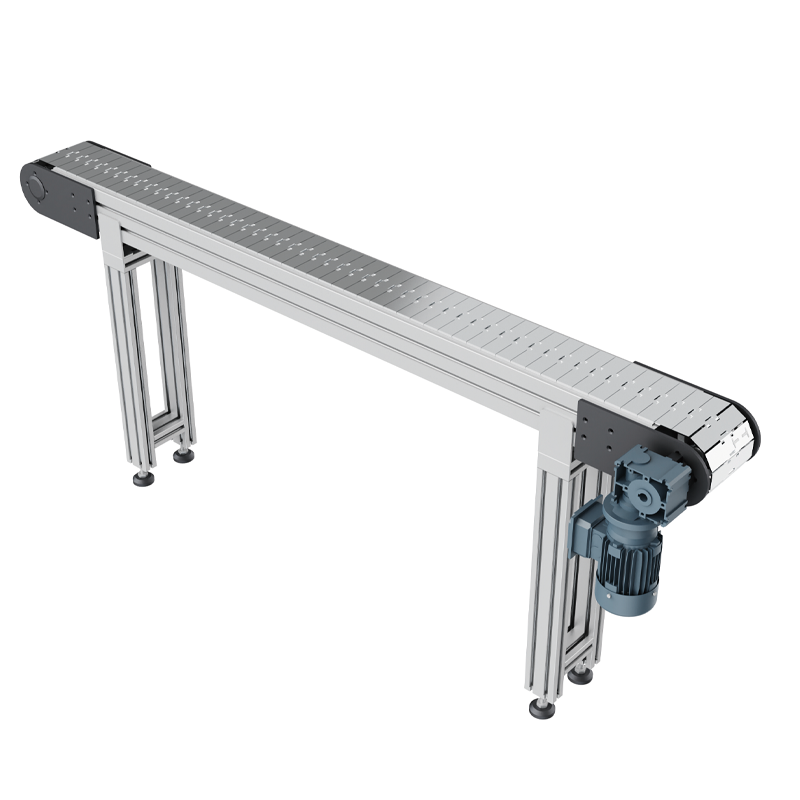Overhead chain conveyors stand as an epitome of engineering excellence, providing a durable and reliable transport solution. The overhead chain conveyors system operates above the work areas, liberating valuable floor space and creating an organized and obstacle-free environment.
Description
Overhead Chain Conveyors for Food
Overhead chain conveyors are a breakthrough innovation that transcends the limitations of traditional belt conveyors. It eliminates common issues. Such as maintenance challenges, difficult belt replacements, and cleaning struggles, not to mention susceptibility to tearing, puncturing, and corrosion. So this solution provides customers with a safer, faster, and simpler maintenance experience.
Besides, constructed with a modular plastic belt and sprocket-driven transmission, the conveyor belt stays straight, avoiding snaking or misalignment. Besides, its robust design ensures resistance to cuts, impacts, oil, high temperatures, and water, ensuring hassle-free maintenance and belt replacement, subsequently reducing overall costs.

Categories:
- By Material: Available as stainless steel top plate chains or plastic steel top plate chains.
- By Conveyance: Options include straight, turning, and inclined top plate chains.
- By Function: Varieties comprise flat top chains, toothed chains, keel chains, and modular mesh belt chains.
Overhead Chain Conveyors Product Features:
1. Durable materials, utilizing stainless steel and engineered plastics.
2. Capable of both continuous and intermittent operations.
3. High wear resistance for an extended operational life.
4. Sprocket-driven for smooth transmission and minimal deviation.
5. Modular design for easy disassembly and low maintenance costs.

Overhead Chain Conveyors Applications:
The overhead chain conveyors excel in automating the transport and sorting processes for a diverse range of products including food, canned items, pharmaceuticals, beverages, cosmetics, detergents, paper goods, condiments, dairy, and tobacco.
Chain Plate Widths: Offered in various widths—63.5, 82.5, 101.6, 114.3, 152.4, 190.5, 254, 304.8 mm; and turning plate widths of 82.5, 114.3, 152.4, 190.5, 304.8 mm.
Detailed Applications
Food Industry: Within the realm of food production, overhead chain conveyors are instrumental in moving an array of foodstuffs—raw, semi-finished, and finished. For example, in a bakery setup, an overhead conveyor transports ingredients like flour and sugar to the mixing area. Subsequently, the prepared dough to the oven.
Beverage lines use the conveyor to move liquids and sweeteners for mixing before bottling. Meat processing plants utilize conveyors for moving large meat portions to cutting equipment, then forwarding sliced meats for packaging.
Pharmaceutical Industry: The pharmaceutical sector relies on overhead chain conveyors to streamline packaging and transport of medications. So these systems efficiently feed pills to packaging stations or direct them towards injectable units. Additionally, they facilitate the swift transfer of drugs to various destinations within the facility.
Chemical Industry: Overhead chain conveyors serve a pivotal function in chemical manufacturing, handling the transfer and processing of chemical substances. So they feed raw materials into reactors for chemical reactions and move them onto evaporators for substance purification, ensuring expeditious and safe delivery of chemicals throughout the plant.
Electronic Product Manufacturing: The electronics industry benefits from overhead chain conveyors for the movement and assembly of components. They transport parts to assembly lines, deliver assembled products for testing, and aid in distributing components rapidly throughout the manufacturing process.
Tobacco Industry: Overhead chain conveyors are integral to the processing and packaging in the tobacco industry, taking tobacco leaves to the processing equipment. Then moving the processed product to packaging stations. They also assist in the fast distribution of tobacco within the production facility.
In Conclusion
The overhead chain conveyors are a versatile piece of material handling equipment prevalent across numerous industries. Composed of a chain, chain plates, a driving mechanism, supports, and guide rails, it boasts the ability to transport materials over long distances with a high capacity, efficiency, and dependable operation. Below is an overview of various sectors where chain conveyors play a critical role.
In conclusion, overhead chain conveyors are widely implemented due to their adaptability to different working conditions and requirements. With ongoing technological progress and evolving operational demands, the scope of chain conveyors’ applications is set to expand even further across diverse sectors.
Maintenance and Upkeep:
All in all, key maintenance practices include:
- Cleanliness: Maintain a clean equipment exterior and interior. Ensure there’s no oil on sliding surfaces, screws, racks, gear boxes, etc., and keep equipment free from leaks. Remove any debris or dirt in and around the equipment.
- Orderliness: Keep tools, attachments, and workpieces organized, and maintain tidy pipes and cables.
- Lubrication: Timely oil application and changing, sustained oiling, maintaining proper oil pressure, clean oil markers, clear oil paths. And it ensures oil quality complies with equipment requirements.
- Safety: Follow safety procedures to avoid overloading and ensure equipment protection devices are operational and reliable. Promptly address any potential safety hazards.
Overhead Chain Conveyors Safety Operation Guidelines:
- Wear personal protective equipment correctly. – Before operation, inspect the machine thoroughly, ensure no obstacles are present, and prepare for startup, ensuring no one is on the chain plate or tail wheel.
- Check switch functionality before starting, run the conveyor with no load first, and do not disable interlocks without verification.
- After shutdown, ensure the chain plate is clear. Avoid stopping or starting under load whenever possible.
- Regularly inspect the operation for motor, reducer, and wheel functionality, sweep for material spillage, check lubrication, verify normal operation sounds, and ensure temperatures remain within safe operating limits.





